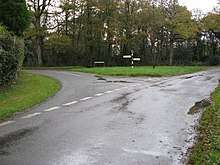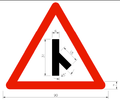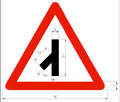Three-way junction
A three-way junction (or three-way intersection) is a type of road intersection with three arms. A Y junction (or Y intersection) generally has three arms of equal size. A T junction (or T intersection) also has three arms, but one of the arms is generally a minor road connecting to a larger road.

Right-of-way
Some T junctions are controlled by traffic lights, but others rely upon drivers to obey right-of-way rules, which vary from place to place. For example, in some jurisdictions, vehicles on the right always have the right-of-way (even at T junctions),[1] while in other jurisdictions, vehicles travelling on the "through" road of a T junction have the right-of-way, meaning that vehicles approaching the "major" road must allow through traffic to pass before joining the flow of traffic.
In the People's Republic of China, going straight on red when approaching a T junction on the main road with the intersecting road on the left was permitted until the Road Traffic Safety Law of the People's Republic of China took effect on 1 May 2004.
In Taiwan (administered by the Republic of China), when at least two vehicles reach a T intersection without a working traffic light, the vehicle on the side road is to yield to any other vehicle straight on the main road. If two vehicles want to turn left, the vehicle on the left is to yield.[2]
Turns
When one road at a 3-way junction has a higher traffic volume than the other (and particularly when the roads are perpendicular to each other), turns are characterized as "right-in", "right-out", "left-in" and "left-out". A turn "in" represents a turn from the major road into the minor road. A turn "out" represents a turn out of the minor road onto the major road. A 3-way junction allowing all four of these turns is characterized as "full-movement". These terms also apply to turns between roads and driveways.[3][4]
Variations
An experiment was done in Illinois, United States to allow going straight on red (like a right turn on red) when approaching a T junction on the main road, with the intersecting road on the left. It was a failure. However, at some T junctions where the main road includes at least two lanes on the side away from the intersecting road, the farthest (rightmost, in areas where traffic drives to the right) lane is given the right of way to proceed straight through the intersection at all times, denoted by a "green arrow" signal if a traffic light is installed at the intersection.
In such cases, often that lane is also specially delimited with pavement markings or other lane separation devices, to keep left-turning traffic on the intersecting road from colliding with traffic proceeding through the intersection on the main road. There are now safer variations of this, called continuous green-T (or seagull) intersections, that have a left turn lane off the main road either channelized or otherwise separated from traffic going straight, which allows for a traffic signal on only one side of the road.[5]
Image gallery
 T Intersection Sign in Taiwan with no more road straight ahead
T Intersection Sign in Taiwan with no more road straight ahead T Intersection Sign in Taiwan with side road on the left
T Intersection Sign in Taiwan with side road on the left T Intersection Sign in Taiwan with side road on the right
T Intersection Sign in Taiwan with side road on the right Y Intersection Sign in Taiwan
Y Intersection Sign in Taiwan 3-way Intersection Sign in Taiwan with side road on the right but not right angle
3-way Intersection Sign in Taiwan with side road on the right but not right angle 3-way Intersection Sign in Taiwan with side road on the left but not right angle
3-way Intersection Sign in Taiwan with side road on the left but not right angle
References
- SGI. "SGI - Driver's Handbook - Right of way".
- Clause 2 of Section 1 of Article 102 of the Road Traffic Security Rules (s:zh:道路交通安全規則)
- Staff. "Technical Summary (FHWA-SA-10-002)". Access Management in the Vicinity of Intersections. Federal Highway Administration. Retrieved August 31, 2012.
- Joe G. Bared (January–February 2005). "Improving Signalized Intersections, Publication Number: FHWA-HRT-05-003". Public Roads. Federal Highway Administration. 68 (4). Retrieved August 31, 2012.
- An Applied Technology and Traffic Analysis Program ("Archived copy". Archived from the original on 2012-02-08. Retrieved 2007-10-12.CS1 maint: archived copy as title (link))
| Wikimedia Commons has media related to Three-way road junctions. |